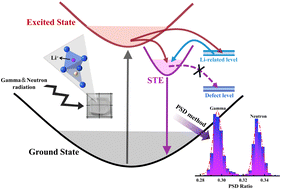An all-inorganic Li-doped Cs3Cu2I5 single crystal for dual gamma ray and neutron detection applications†
Abstract
Recently, the all-inorganic metal halide Cs3Cu2I5 has attracted extensive attention because of its potential use in X-ray and gamma ray detection. Herein, a high-quality and efficient Li+-doped Cs3Cu2I5 single crystal with good air stability was grown and utilized for dual gamma ray and neutron detection for the first time. X-ray diffraction, X-ray photoelectron spectroscopy, inductively coupled plasma optical emission spectrometry, and nuclear magnetic resonance were employed to prove that Li+ was successfully introduced into Cs3Cu2I5, and the lattice sites of Li+ were investigated. The photoluminescence quantum efficiency of the Cs3Cu2I5 crystal was improved from 83.4% to 88.6% via Li+ doping. The photoluminescence and X-ray results showed that the emission peak of Cs3Cu2I5:Li was located at 445 nm and was ascribed to the self-trapped exciton emission. The light yield and energy resolution of the Cs3Cu2I5 crystal were significantly improved under 137Cs irradiation after Li+ doping. The effects of the Li+ doping on the performance were also investigated. In particular, the Cs3Cu2I5:Li crystal achieved an excellent figure-of-merit of 2.25, which showed its significant potential for dual gamma-ray and neutron detection applications.



 Please wait while we load your content...
Please wait while we load your content...